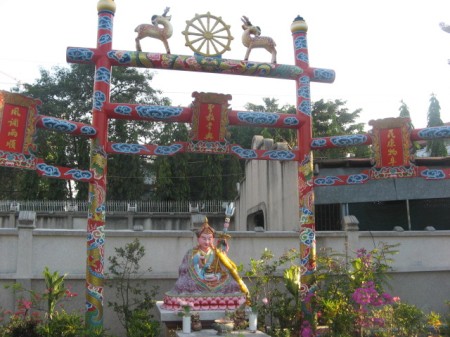Pemergian seorang pemimpin ulung Parti Komunis Malaya: Suriani Abdullah/Eng Ming Ching
Lee Siew Hwa
21/3/2013
Suriani Abdullah/Eng Ming Ching – anak perempuan dan ibu kepada tanah air tercinta telah meninggal dunia pada 21 Mac 2013 – di Ban Chulaborn 12, wilayah Sukhirin, selatan negara Thai.
Pada tahun 2002, sewaktu saya memulakan dokumentasi sejarah lisan wanita sosialis berhaluan kiri ( gerakan pelajar, buruh dan parti sosialis) yang berkecimpung di dalam perjuangan menegakkan demokrasi terutama pada tahun-tahun 1950 – 1970. Saya terjumpa seorang pejuang wanita yang ulung lagi luar biasa yang telah menjadi sebahagian sejarah anti-penjajah untuk mendapatkan kemerdekaan dan itu telah benar2 mencetus pemikiran saya secara mendalam.
Beliau merupakan seorang bekas aktivis pelajar, penyelaras buruh dan juga seorang pemimpin di Parti Komunis Malaya. Beliau serta ramai pemimpin/kader telah menetap di Ban Chulaborn 12, wilayah Sukhirin selatan Thai selepas persetujuan damai tercapai pada tahun 1989.
Perkara yg membuat beliau sebegitu menerujakan saya adalah pendirian/ perjuangan beliau terhadap pembebasan Malaya dari penjajahan fascis Jepun dan juga imperialis British.
Perang pembebasan yang telah mereka lancarkan di dalam hutan bagi membela/membebaskan Malaya dari cengkaman penjajahan telah berlarutan bertahun-tahun demi pembebasan rakyat dari kezaliman pihak penjajah.
Secara rasminya, catatan sejarah Malaysia dan penjajah British telah mencatatkan perjuangan ini sebagai sebuah ‘keganasan’ dan mendakwa bahawa mereka adalah” pengganas” yang mahu mengambil alih Malaya.
Yang sebenarnya, mereka ini adalah rakyat patriotik Malaya dan Singapura yang telah bangun melancarkan peperangan pembebasan tanah air dari kekecaman penjajahan. Malaya yang telah merdeka hari ini mungkin tidak akan wujud tanpa perang yang telah dilancarkan terhadap penjajah oleh PKM.
Hari ini, 21 Mar 2013, adalah hari pemergiannya arwah ibu/rakan Suriani Abdullah. Penghormatan tertinggi kami untuk beliau dan juga kepada semua yang telah terlibat, mereka telah memberikan seluruh kehidupan dan nyawa buat kebebasan tanah air ini. ‘Makcik’ – jiwamu sentiasa dengan kami. Semuga roh mu dicucuri. Kami tidak akan sekali-kali melupakan jasa-jasamu – wahai negarawan ibu yang telah mencurahkan kasih dan pengorbanan besar kepada negara tanpa berbelah bagi. Semuga roh mu dicucuri. Sejarah, adalah hakim terbaik buat keadilan.
The passing of extraordinary leader of Communist Party Malaya :Suriani Abdullah/’Eng Ming Ching’/应敏钦.: The patriotic daughter and mother of this land:
21 March 2012-Ban Chulabhorn 12 in Sukhirin, southern Thailand.
In year 2002, when I started to conduct the oral history documentation of the socialist left women who were participated in the Democratic struggle especially during the time of 1950-70.
I found and met a very rare, extraordinary female revolutionary fighter figure that was part of the past anti colonial independent struggle that deeply strike my mind. She was ex students activists, labour organizer and also the leader of Communist Party Malaya, Suriani Abdullah < in Chinese: >.She and other CPM leaders/cadre reside at the Ban Chulabhorn 12 in Sukhirin, southern Thailand since after the peace accord in year 1989.
What really make her surprise for me is that her conviction to the liberation of the nation to free from the Japanese and British Colonial. The wars that they waged in the jungle to defend this land of Malaya for ages for the cause of the nation and people to be free from cruelty hands of colonizers.
The Malaysia official state and British colonial history portrayed this struggle a s “terrorism” and claimed that these are aggressors that wanted to take over Malaya.
As in real, these people of Malaya and Singapore who had waged the war in the jungle were the patriotic who defended the land of Malaya and Sigapore from the hands of colonialistion.
The independent of Malaya may not come even if these wars against colonialisation were not being wage.
Today 21 March 2013, the passing of Suriani Abdullah – Our deepest salute to her and the rest of them who have given their whole life for the independent liberation of this nation.
“Makcik” ,Your spirits will be always with us. May you rest in peace. We will not forget you – alike our mother who had nurtured this land with your selfless love and sacrifice May you rest in peace and history is the best judgments in the truth of justice.
Ps: More URL about their struggle and life at southern Thailand:
About Suriani Abdulla and Regime 10:
http://matamin.blogspot.com/2009/05/rejimen-ke-10-sejarah-yang.html
http://jameswongwingon-online.blogspot.com/2006/03/makcik-suriani-abdullahs-memoirs-out.html



























